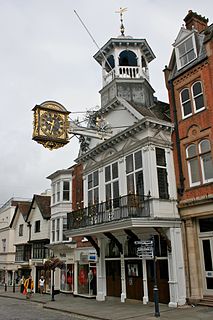
A guildhall is either a town hall, or a building historically used by guilds for meetings and other purposes, in which sense it can also be spelled as "guild hall" and may also be called a "guild house". It is also the official or colloquial name for many of these specific buildings, many of which are now museums.

Totnes Guildhall is a 16th-century Tudor historic guildhall, magistrate's court, and prison, in the town of Totnes, south Devon, in southwest England. It is a Grade I listed building.

Exeter Guildhall on the High Street of Exeter, Devon, England has been the centre of civic government for the city for at least 600 years. Much of the fabric of the building is medieval, though the elaborate frontage was added in the 1590s and the interior was extensively restored in the 19th century. It is a Grade I listed building.

The Rochester Guildhall is an historic building located in the High Street in Rochester, Kent, England. It is a Grade I listed building.

St Mary's Hall is a municipal building in Bayley Lane in Coventry, West Midlands, England. It is a Grade I listed building.

The Guildford Guildhall is a Guildhall located on the High Street of the town of Guildford, Surrey. It is a Grade I listed building.

The Much Wenlock Guildhall is a guildhall located on Wilmore Street in Much Wenlock, Shropshire. It is a Grade II* listed building.

The Worcester Guildhall is a municipal building in the High Street, Worcester, England. It is a Grade I listed building.

Winchester Guildhall is a municipal building in the High Street, Winchester, Hampshire. It is a Grade II listed building.

Thaxted Guildhall is a municipal building in Thaxted, Essex, England. It is a Grade I listed building.

The Old Shirehall was a municipal facility in Market Square, Shrewsbury, Shropshire. It was demolished in 1971 to make way for a retail and commercial centre.

Wokingham Town Hall is a municipal building in the Market Place in Wokingham, Berkshire, England. The building is the meeting place of Wokingham Town Council and is a Grade II* listed building.

Launceston Guildhall and Town Hall is a municipal building in Western Road in Launceston, Cornwall, England. The building, which was the meeting place of Launceston Town Council, is a Grade II listed building.

}

Tiverton Town Hall is a municipal building in St Andrew Street in Tiverton, Devon, England. The structure, which was the meeting place of Tiverton Borough Council, is a Grade II listed building.

Carmarthen Guildhall is a municipal structure in Guildhall Square, Carmarthen, Wales. The guildhall, which was the headquarters of Carmarthen Borough Council, is a Grade I listed building.

Montrose Town House, also known as Montrose Guildhall, is a municipal building in the High Street, Montrose, Scotland. The building, which was the headquarters of Montrose Burgh Council, is a Category A listed building.

Great Torrington Town Hall is a municipal building in the High Street, Great Torrington, Devon, England. The town hall, which is the meeting place of Great Torrington Town Council, is a Grade II listed building.

Chipping Norton Town Hall is a municipal building in the Market Place, Chipping Norton, Oxfordshire, England. The building, which is used as an events venue, is a Grade II* listed building.

Queenborough Guildhall is a former municipal building in the High Street in Queenborough, Kent, England. The structure, which is currently used as a museum, is a Grade II listed building.





















